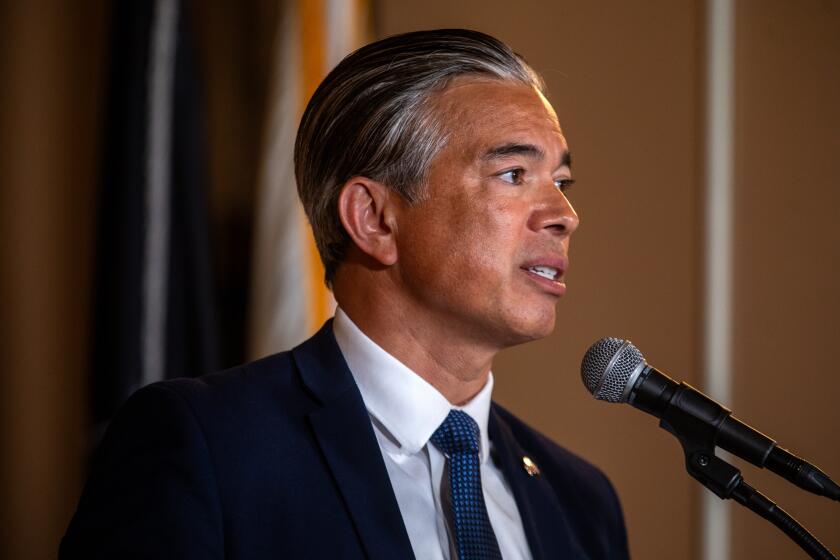Some Seek ‘Suicide by Cops,’ Study Finds
A study by the Los Angeles County Sheriff’s Department has concluded that in 10% of the cases in which deputies fatally shot someone, they were goaded into it by suspects who wanted to die.
The 1997 report, which was recently made public, reconstructed 384 shootings between 1987 and 1996 and determined that about 35 of the incidents were “suicide by cop,” a law enforcement catch phrase for those who deliberately provoke officers into killing them.
Sheriff’s officials say “suicide by cop” has caused a reexamination of certain procedures in an effort to save lives and spare officers from the emotional trauma of needless shootings.
One result: When deputies in an Antelope Valley desert area earlier this month were confronted by an armed man who continued resisting after being shot with “beanbag” rounds, they determined he was no danger to anyone else in the isolated area near Valyermo.
So they took an unusual step for law enforcement officers--they just went away.
The man eventually returned home, without harming himself or anyone else, deputies said.
“We’ve taken this very seriously,” said Dr. Barry Perrou, head of the sheriff’s crisis negotiation team and the department’s expert on the issue.
“We have given a very high priority to how we handle situations that could be suicide by cop. We handle it differently,” now, he said.
The Valyermo incident was an example, sheriff’s officials said.
Although research is spotty--only Florida and Oregon authorities have conducted similar studies into the phenomenon--initial research shows similarities among those who appear to deliberately provoke police into shooting them, the initial research shows.
The Sheriff’s Department study, in which Perrou was involved, said the average age of suicide-by-cop suspects was 35. An overwhelming majority (about 96%) were male and had loaded guns when confronted by police. In addition, most had psychiatric problems and most asked police to kill them.
The sheriff’s study also revealed half the shooting victims they believe were suicidal had drug or alcohol problems, 38% had made previous attempts on their lives, 42% had a history of domestic violence and 38% had a criminal record.
Sheriff’s officials refused to give specific examples of the evidence they used to conclude that some shootings were self-induced. Some of the cases are still open, they said.
*
There are examples elsewhere, however.
A case of probable suicide by cop cited in this month’s FBI Law Enforcement Bulletin told of Philadelphia police who cornered a burglary suspect at a local school with the help of police dogs.
Crying, “Shoot me, shoot me,” the man aimed a pistol at police, who did. The pistol turned out to be a starter’s gun, and an investigation into his death found he had been hospitalized for a suicide attempt.
Sheriff’s officials say the report is helping them develop protocols from the time the emergency call comes in to dispatchers and following through to strategies used in the field by special weapons and tactics units and crisis negotiation teams.
With information about alcohol consumption, for example, authorities can determine whether an individual has lowered inhibitions, Perrou said.
In a confrontation like the Valyermo incident, in a rural area where no other lives were at risk, leaving the suicidal person alone may save a life, said Sheriff’s Lt. Bob Rifkin.
“Would we have done the same thing if he was in a house in a populated area--probably not,” Rifkin said.
The Los Angeles Police Department is trying to deal with the suicide-by-cop phenomenon by using nonlethal weapons, such as stun guns, beanbag rounds, Tasers, pepper spray and flash-bang grenades when possible.
“Occasionally, you may have the luxury of time in deploying less-than-lethal-force, but many times you do not have that luxury,” Cmdr. David Kalish said. “In many cases we will never know what a person’s intent was. That’s what makes law enforcement such a dangerous job.”
In addition to the loss of life, sheriff’s deputies often must contend with lasting emotional trauma from suicide-by-cop cases, sheriff’s officials said.
“I don’t think the public always understands that officers are affected by being involved in a shooting,” said Audrey Honig, with the department’s employee support services.
“When you’ve got a situation that involves suicide by cop, officers don’t take well to being used like that. There are what-ifs and ‘Could I have done something different?’ as well an increased sense of your own mortality that goes with any officer-involved shooting,” she added.
*
The research was praised by Merrick Bobb, an attorney appointed by the County Board of Supervisors to monitor reform in the Sheriff’s Department and by the Los Angeles Police Commission to oversee such efforts in the LAPD.
“This kind of analysis is cutting edge and a fresh way to look at the tactics and strategy employed by the police in potentially violent confrontations,” Bobb said.
“The strategic issue it raises is: Is there some way to bring the situation to a close without compromising safety, in a way that is less violent and not necessarily deadly?”
“The primary mission of the police is to safeguard lives,” added Mike Scott, Savannah, Ga.-based author and police management consultant.
“To the extent they can recognize suicidal individuals and prevent those suicides, the police can protect citizens’ lives as well as their own.”
More to Read
Start your day right
Sign up for Essential California for news, features and recommendations from the L.A. Times and beyond in your inbox six days a week.
You may occasionally receive promotional content from the Los Angeles Times.






